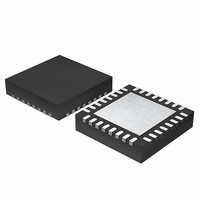EFM32G200F64 Energy Micro, EFM32G200F64 Datasheet - Page 18

EFM32G200F64
Manufacturer Part Number
EFM32G200F64
Description
MCU 32BIT 64KB FLASH 32-QFN
Manufacturer
Energy Micro
Series
Geckor
Datasheets
1.EFM32G200F16.pdf
(63 pages)
2.EFM32G200F16.pdf
(10 pages)
3.EFM32G200F16.pdf
(463 pages)
4.EFM32G200F16.pdf
(136 pages)
Specifications of EFM32G200F64
Core Processor
ARM® Cortex-M3™
Core Size
32-Bit
Speed
32MHz
Connectivity
EBI/EMI, I²C, IrDA, SmartCard, SPI, UART/USART
Peripherals
Brown-out Detect/Reset, DMA, POR, PWM, WDT
Number Of I /o
24
Program Memory Size
64KB (64K x 8)
Program Memory Type
FLASH
Ram Size
16K x 8
Voltage - Supply (vcc/vdd)
1.8 V ~ 3.8 V
Data Converters
A/D 4x12b, D/A 1x12b
Oscillator Type
External
Operating Temperature
-40°C ~ 85°C
Package / Case
32-VQFN Exposed Pad
Processor Series
EFM32G200
Core
ARM Cortex-M3
Data Bus Width
32 bit
Data Ram Size
16 KB
Interface Type
I2C, UART
Maximum Clock Frequency
32 MHz
Number Of Programmable I/os
24
Number Of Timers
2
Operating Supply Voltage
1.8 V to 3.8 V
Maximum Operating Temperature
+ 85 C
Mounting Style
SMD/SMT
Minimum Operating Temperature
- 40 C
Lead Free Status / RoHS Status
Lead free / RoHS Compliant
Eeprom Size
-
Lead Free Status / Rohs Status
Details
Available stocks
Company
Part Number
Manufacturer
Quantity
Price
- EFM32G200F16 PDF datasheet
- EFM32G200F16 PDF datasheet #2
- EFM32G200F16 PDF datasheet #3
- EFM32G200F16 PDF datasheet #4
- Current page: 18 of 463
- Download datasheet (8Mb)
5.2.3.2 Access Performance
5.3 Access to Low Energy Peripherals (Asynchronous Registers)
5.3.1 Introduction
2010-09-06 - d0001_Rev1.00
The Bus Matrix is a multi-layer energy optimized AMBA AHB compliant bus with an internal bandwidth
of 4x a single AHB interface.
The Bus Matrix accepts new transfers to be initiated by each master in each cycle without inserting any
wait-states. However, the slaves may insert wait-states depending on their internal throughput and the
clock frequency.
The Cortex-M3 and the DMA Controller, and the peripherals (not peripherals in the low frequency clock
domain) run on clocks which can be prescaled separately. When accessing a peripheral which runs on
a frequency equal to or faster than the HFCORECLK, the number of wait cycles per access, in addition
to master arbitration, is given by:
Memory Wait Cycles with Clock Equal or Faster than the HFCORECLK
where N
When accessing a peripheral which runs on a slower clock than the HFCORECLK, wait cycles are
introduced to allow the transfer to complete on the peripheral clock. The number of wait cycles per
access, in addition to master arbitration, is given by:
Memory Wait Cycles with Clock Slower than the CPU
where N
Clocks and prescaling are described in more detail in Chapter 11 (p. 90) .
The Low Energy Peripherals are capable of running when the high frequency oscillator and core system
is powered off, i.e. in energy modes EM2 and in some cases also EM3. This enables the peripherals to
perform tasks while the system energy consumption is minimal.
The Low Energy Peripherals are:
• Liquid Crystal Display driver - LCD
• Low Energy Timer - LETIMER
• Low Energy UART - LEUART
• Pulse Counter - PCNT
• Real Time Counter - RTC
• Watchdog - WDOG
All Low Energy Peripherals are memory mapped, with standardized data synchronization support.
Because the Low Energy Peripherals are running on clocks asynchronous to the core clock, there are
some constraints on how register accesses are performed, as described in the following sections. The
constraints are however standardized across all Low Energy Peripherals.
slave cycles
slave cycles
is the wait cycles introduced by the slave.
is the wait cycles introduced by the slave.
N
cycles
= (2 + N
N
cycles
slave cycles
= 2 + N
) x f
...the world's most energy friendly microcontrollers
slave cycles
18
HFCORECLK
/f
HFPERCLK
www.energymicro.com
(5.3)
(5.4)
Related parts for EFM32G200F64
Image
Part Number
Description
Manufacturer
Datasheet
Request
R

Part Number:
Description:
KIT STARTER EFM32 GECKO
Manufacturer:
Energy Micro
Datasheet:

Part Number:
Description:
KIT DEV EFM32 GECKO LCD SUPPORT
Manufacturer:
Energy Micro
Datasheet:

Part Number:
Description:
BOARD PROTOTYPING FOR EFM32
Manufacturer:
Energy Micro
Datasheet:

Part Number:
Description:
KIT DEVELOPMENT EFM32 GECKO
Manufacturer:
Energy Micro
Datasheet:

Part Number:
Description:
MCU, MPU & DSP Development Tools TG840 Sample Kit
Manufacturer:
Energy Micro
Datasheet:

Part Number:
Description:
MCU, MPU & DSP Development Tools TG Starter Kit
Manufacturer:
Energy Micro
Datasheet:

Part Number:
Description:
MCU, MPU & DSP Development Tools TG108 Sample Kit
Manufacturer:
Energy Micro

Part Number:
Description:
MCU, MPU & DSP Development Tools TG210 Sample Kit
Manufacturer:
Energy Micro
Datasheet:

Part Number:
Description:
MCU, MPU & DSP Development Tools TG822 Sample Kit
Manufacturer:
Energy Micro
Datasheet:

Part Number:
Description:
MCU, MPU & DSP Development Tools TG230 Sample Kit
Manufacturer:
Energy Micro

Part Number:
Description:
SAMPLE KIT (SMALL BOX - CONTAINING 2 DEVICES)
Manufacturer:
Energy Micro

Part Number:
Description:
SAMPLE KIT (SMALL BOX - CONTAINING 2 DEVICES)
Manufacturer:
Energy Micro











